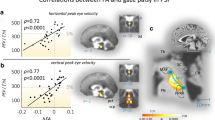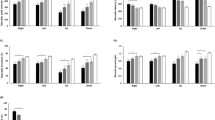Abstract
Backgrounds
This study aims to characterize eye movement abnormalities in Wilson disease and examine their association with the degree of brainstem atrophy.
Methods
Twenty patients (10 males, mean age 46.8, SD 8.9 years) with genetically confirmed neurological WD on stable anti-copper treatment and 20 age- and sex-matched healthy subjects were examined. Eye movements, including prosaccade and antisaccade tasks, were evaluated using infrared videooculography. MRI was performed using 1.5 T system, and T2-weighted images were used for the measurement of midbrain and pontine area on mid-sagittal slices. Clinical severity was assessed using the Unified Wilson’s Disease Rating Scale (UWDRS).
Results
Compared to healthy controls, WD patients showed prolonged latencies of horizontal prosaccades and hypometry of both horizontal (p = 0.04) and vertical (p = 0.0046) prosaccades. In the antisaccade task, WD patients showed prolonged latency of both horizontal (p = 0.04) and vertical antisaccades (p = 0.047) and increased error rate of vertical antisaccades (p = 0.04). There is a significant association between midbrain area and horizontal latencies (r = −0.53; p = 0.02) and vertical maximum speed in prosaccades (r = 0.47; p = 0.04). The pons area inversely correlated with horizontal prosaccade and antisaccade latencies (p = 0.007).
Conclusions
We showed impairments of ocular saccades such as prolonged latencies, hypometry, and increased error rate in antisaccades. The strong association between prolonged latencies of prosaccades and the brainstem atrophy suggests that VOG might serve as a sensitive electrophysiological marker of brainstem dysfunction in WD.




Similar content being viewed by others
References
Członkowska A, Litwin T, Dusek P, Ferenci P, Lutsenko S, Medici V, Rybakowski JK, Weiss KH, Schilsky ML (2018) Wilson disease. Nat Rev Dis Primer 4:21. https://doi.org/10.1038/s41572-018-0018-3
Horoupian DS, Sternlieb I, Scheinberg IH (1988) Neuropathological findings in penicillamine-treated patients with Wilson’s disease. Clin Neuropathol 7:62–67
King AD, Walshe JM, Kendall BE, Chinn RJ, Paley MN, Wilkinson ID, Halligan S, Hall-Craggs MA (1996) Cranial MR imaging in Wilson’s disease. AJR Am J Roentgenol 167:1579–1584. https://doi.org/10.2214/ajr.167.6.8956601
Dusek P, Litwin T, Członkowska A (2019) Neurologic impairment in Wilson disease. Ann Transl Med 7:S64. https://doi.org/10.21037/atm.2019.02.43
Bandmann O, Weiss KH, Kaler SG (2015) Wilson’s disease and other neurological copper disorders. Lancet Neurol 14:103–113. https://doi.org/10.1016/S1474-4422(14)70190-5
Leśniak M, Członkowska A, Seniów J (2008) Abnormal antisaccades and smooth pursuit eye movements in patients with Wilson’s disease. Mov Disord Off J Mov Disord Soc 23:2067–2073. https://doi.org/10.1002/mds.22276
Tribl GG, Trindade MC, Bittencourt T, Lorenzi-Filho G, Cardoso Alves R, Ciampi de Andrade D, Fonoff ET, Bor-Seng-Shu E, Machado AA, Schenck CH, Teixeira MJ, Barbosa ER (2016) Wilson’s disease with and without rapid eye movement sleep behavior disorder compared to healthy matched controls. Sleep Med 17:179–185. https://doi.org/10.1016/j.sleep.2015.09.003
Jung H-K, Choi SY, Kim J-M, Kim J-S (2013) Selective slowing of downward saccades in Wilson’s disease. Parkinsonism Relat Disord 19:134–135. https://doi.org/10.1016/j.parkreldis.2012.05.023
Kirkham TH, Kamin DF (1974) Slow saccadic eye movements in Wilson’s disease. J Neurol Neurosurg Psychiatry 37:191–194. https://doi.org/10.1136/jnnp.37.2.191
Ingster-Moati I, Bui Quoc E, Pless M, Djomby R, Orssaud C, Guichard JP, Woimant F (2007) Ocular motility and Wilson’s disease: a study on 34 patients. J Neurol Neurosurg Psychiatry 78:1199–1201. https://doi.org/10.1136/jnnp.2006.108415
Vintonyak O, Gorges M, Müller H-P, Pinkhardt EH, Ludolph AC, Huppertz HJ, Kassubek J (2017) Patterns of eye movement impairment correlate with regional brain atrophy in neurodegenerative parkinsonism. Neurodegener Dis 17:117–126. https://doi.org/10.1159/000454880
Semnic R, Svetel M, Dragasevic N, Petrovic I, Kozic D, Marinkovic J, Kostic VS, Sener RN (2005) Magnetic resonance imaging morphometry of the midbrain in patients with Wilson disease. J Comput Assist Tomogr 29:880–883. https://doi.org/10.1097/01.rct.0000181723.61974.51
Strecker K, Schneider JP, Barthel H, Hermann W, Wegner F, Wagner A, Schwarz J, Sabri O, Zimmer C (2006) Profound midbrain atrophy in patients with Wilson’s disease and neurological symptoms? J Neurol 253:1024–1029. https://doi.org/10.1007/s00415-006-0151-x
Członkowska A, Tarnacka B, Möller JC, Leinweber B, Bandmann O, Woimant F, Oertel WH (2007) Unified Wilson’s disease rating scale - a proposal for the neurological scoring of Wilson’s disease patients. Neurol Neurochir Pol 41:1–12
Oba H, Yagishita A, Terada H, Barkovich AJ, Kutomi K, Yamauchi T, Furui S, Shimizu T, Uchigata M, Matsumura K, Sonoo M, Sakai M, Takada K, Harasawa A, Takeshita K, Kohtake H, Tanaka H, Suzuki S (2005) New and reliable MRI diagnosis for progressive supranuclear palsy. Neurology 64:2050–2055. https://doi.org/10.1212/01.WNL.0000165960.04422.D0
Antoniades CA, Kennard C (2015) Ocular motor abnormalities in neurodegenerative disorders. Eye Lond Engl 29:200–207. https://doi.org/10.1038/eye.2014.276
Jankovic J (2008) Parkinson’s disease: clinical features and diagnosis. J Neurol Neurosurg Psychiatry 79:368–376. https://doi.org/10.1136/jnnp.2007.131045
Sinha S, Taly AB, Prashanth LK, Ravishankar S, Arunodaya GR, Vasudev MK (2007) Sequential MRI changes in Wilson’s disease with de-coppering therapy: a study of 50 patients. Br J Radiol 80:744–749. https://doi.org/10.1259/bjr/48911350
Butinar D, Trontelj JV, Khuraibet AJ, Khan RA, Hussein JM, Shakir RA (1990) Brainstem auditory evoked potentials in Wilson’s disease. J Neurol Sci 95:163–169. https://doi.org/10.1016/0022-510x(90)90239-j
Beh SC, Frohman TC, Frohman EM (2017) Cerebellar control of eye movements. J Neuro-Ophthalmol Off J North Am Neuro-Ophthalmol Soc 37:87–98. https://doi.org/10.1097/WNO.0000000000000456
Robinson FR, Fuchs AF (2001) The role of the cerebellum in voluntary eye movements. Annu Rev Neurosci 24:981–1004. https://doi.org/10.1146/annurev.neuro.24.1.981
Rottach KG, Riley DE, DiScenna AO, Zivotofsky AZ, Leigh RJ (1996) Dynamic properties of horizontal and vertical eye movements in parkinsonian syndromes. Ann Neurol 39:368–377. https://doi.org/10.1002/ana.410390314
Condy C, Wattiez N, Rivaud-Pechoux S et al (2006) Antisaccade deficit after inactivation of the principal sulcus in monkeys. Cereb Cortex 17:221–229. https://doi.org/10.1093/cercor/bhj140
Ploner CJ, Gaymard BM, Rivaud-Péchoux S, Pierrot-Deseilligny C (2005) The prefrontal substrate of reflexive saccade inhibition in humans. Biol Psychiatry 57:1159–1165. https://doi.org/10.1016/j.biopsych.2005.02.017
Frota NAF, Caramelli P, Barbosa ER (2009) Cognitive impairment in Wilson’s disease. Dement Neuropsychol 3:16–21. https://doi.org/10.1590/S1980-57642009DN30100004
Hegde S, Sinha S, Rao SL et al (2010) Cognitive profile and structural findings in Wilson’s disease: a neuropsychological and MRI-based study. Neurol India 58:708–713. https://doi.org/10.4103/0028-3886.72172
Rathbun JK (1996) Neuropsychological aspects of Wilson’s disease. Int J Neurosci 85:221–229
Goldring J, Fischer B (1997) Reaction times of vertical prosaccades and antisaccades in gap and overlap tasks. Exp Brain Res 113:88–103. https://doi.org/10.1007/bf02454145
Bonnet C, Hanuška J, Rusz J et al (2013) Horizontal and vertical eye movement metrics: what is important? Clin Neurophysiol Off J Int Fed Clin Neurophysiol 124:2216–2229. https://doi.org/10.1016/j.clinph.2013.05.002
Lemos J, Pereira D, Almendra L, Rebelo D, Patrício M, Castelhano J, Cunha G, Januário C, Cunha L, Freire A, Castelo-Branco M (2017) Cortical control of vertical and horizontal saccades in progressive supranuclear palsy: an exploratory fMRI study. J Neurol Sci 373:157–166. https://doi.org/10.1016/j.jns.2016.12.049
Irving EL, Lillakas L (2019) Difference between vertical and horizontal saccades across the human lifespan. Exp Eye Res 183:38–45. https://doi.org/10.1016/j.exer.2018.08.020
Acknowledgements
This work was supported by the Czech Ministry of Health (15-25602A).
Author information
Authors and Affiliations
Contributions
All authors contributed to the study conception and design. Material preparation, data collection, and analysis were performed by Hanuška J., Dušek P., Rusz J., Ulmanová O., Burgetová A., and Růžička E. The first draft of the manuscript was written by Hanuška J., and all authors commented on previous versions of the manuscript. All authors read and approved the final manuscript.
Corresponding author
Ethics declarations
Conflict of interest
The authors declare that they have no conflict(s) of interest.
Ethical approval
All procedures performed in studies involving human participants were in accordance with the ethical standards of the institutional and/or national research committee and with the 1964 Helsinki Declaration and its later amendments or comparable ethical standards.
Informed consent
Informed consent was obtained from all individual participants included in the study.
Additional information
Publisher’s note
Springer Nature remains neutral with regard to jurisdictional claims in published maps and institutional affiliations.
Rights and permissions
About this article
Cite this article
Hanuška, J., Dušek, P., Rusz, J. et al. Eye movement abnormalities are associated with brainstem atrophy in Wilson disease. Neurol Sci 41, 1097–1103 (2020). https://doi.org/10.1007/s10072-019-04225-3
Received:
Accepted:
Published:
Issue Date:
DOI: https://doi.org/10.1007/s10072-019-04225-3




